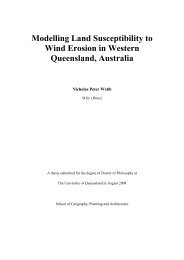Final Report: Strengthening Community Research in ... - Ninti One
Final Report: Strengthening Community Research in ... - Ninti One
Final Report: Strengthening Community Research in ... - Ninti One
Create successful ePaper yourself
Turn your PDF publications into a flip-book with our unique Google optimized e-Paper software.
esearchers have facilitated an <strong>in</strong>crease <strong>in</strong> community awareness and <strong>in</strong>vestment <strong>in</strong> the research and evaluation.They actively develop community representation <strong>in</strong> governance and decision mak<strong>in</strong>g by provid<strong>in</strong>g tangiblerecommendations to the LRG or other community governance boards or organisations. They provide <strong>in</strong>formationto the community as a key stakeholder on their f<strong>in</strong>d<strong>in</strong>gs and provide recommendations that support activestrategies and practical outcomes relat<strong>in</strong>g to Local Implementation Plan (LIP) actions.In consider<strong>in</strong>g future potential, we have observed a number of additional benefits to government work withcommunities <strong>in</strong>clud<strong>in</strong>g:The PAR process fosters greater community engagement with decision mak<strong>in</strong>g processes throughparticipation and steer<strong>in</strong>g of research projectsThe development of ways to explore divergent community aspirations and identify key communitydevelopment issuesInterest of community members <strong>in</strong> ways that participatory methods can explore and repair entrenchedcommunity conflict, disaffection and disengagementDescrib<strong>in</strong>g cultural standpo<strong>in</strong>ts that <strong>in</strong>fluence the way that most community members engage withservice delivery, external stakeholders and government policy.A considered overview of relevant aspects of the policy landscape for RSD communities illustrates how theexpectations of those communities are driven by the cont<strong>in</strong>ued coord<strong>in</strong>ated engagement of the AustralianGovernment.RSD towns: Most RSD communities commonly host numbers of external researchers visit<strong>in</strong>g or revisit<strong>in</strong>gto engage <strong>in</strong> research that requires local <strong>in</strong>put. At times, there can be a number of separate consultantson-site engag<strong>in</strong>g a community <strong>in</strong> various types of research for a range of external clients. The mechanismsfor these external researchers to provide feedback to the community regard<strong>in</strong>g process andrecommendations are extremely unclear.Territory Growth Towns: This is the Northern Territory Government (NTG) name for the communities itis work<strong>in</strong>g with. There are twenty Territory Growth Towns and fifteen of these are RSD communities <strong>in</strong>the Northern Territory. The NTG aims to transform the Territory Growth Towns so that they:− are properly planned and designed− have services, facilities and build<strong>in</strong>gs like any other country town− benefit from targeted <strong>in</strong>vestment <strong>in</strong> <strong>in</strong>frastructureLocal Implementation Plan (LIP): The LIP describes long-term service delivery strategies that aim atachiev<strong>in</strong>g community development and better service delivery outcomes for RSD communities. The rolloutof the LIP <strong>in</strong>volves coord<strong>in</strong>ation of Federal and Territory Governments, Shire Council, nongovernmentorganisations, local bus<strong>in</strong>esses and Aborig<strong>in</strong>al Corporations.Local Reference Groups (LRG): The community LRG is the s<strong>in</strong>gle po<strong>in</strong>t of access between communityrepresentatives and all agencies associated with RSD. Regular meet<strong>in</strong>gs are the occasion that thecommunity representatives (members) meet as a group to monitor the LIP and review RSD progress,accept reports from service providers, agencies and government representatives, or discuss proposals,plans and priorities. The engagement of community members <strong>in</strong> these reference groups varies widelyfrom one community to another. The mechanism of consultation with LRGs applies broadly to all the RSDactivity as the LRGs ‘set the community priorities for the Local Implementation Plan’ (Commonwealth ofAustralia 2010. p. 8).There often exists a gulf between policy development and the engagement of residents <strong>in</strong> policy. N<strong>in</strong>ti <strong>One</strong>recommends the further development of remote community research teams to foster a network of key sites acrossremote Australia. Where multi-l<strong>in</strong>gual community members undertake high quality research, the research is of directbenefit to those communities, and may be made available to a larger <strong>in</strong>ter-cultural audience.The ongo<strong>in</strong>g, susta<strong>in</strong>able growth of this network would build on the success of projects undertaken <strong>in</strong> the previousDesert Knowledge CRC, and maximise new opportunities for Aborig<strong>in</strong>al community researchers. Develop<strong>in</strong>g95
















